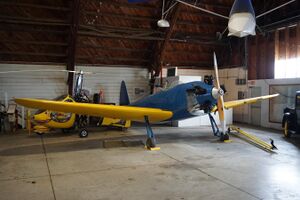Engineering:Howard DGA-18
From HandWiki
| Howard DGA-18 | |
|---|---|

| |
| 1941 Howard DGA-18K at the Arkansas Air & Military Museum in Fayetteville, Arkansas | |
| Role | Civil monoplane trainer |
| National origin | United States |
| Manufacturer | Howard Aircraft Corporation |
| First flight | 1941 |
| Primary user | US Civil Pilot Training Program |
| Number built | ~60 |
The Howard DGA-18 was an American two-seat basic training aircraft designed and built by the Howard Aircraft Corporation for the United States Civil Pilot Training Program.[1]
Design
The United States' Civilian Pilot Training Program resulted in high demand for both primary and advanced training aircraft, and in an attempt to take advantage of this demand, the DGA-18 was designed, with the first example flying in October 1940.[2][3] The DGA-18 was a low-wing cantilever monoplane with two tandem open cockpits and a fixed conventional landing gear. The aircraft was built in three variants with different engines fitted.[1]
Variants
- DGA-18 (or DGA-125)
- Variant powered by a 125 hp (93 kW) Warner Scarab 50 radial engine.[3]
- DGA-18K (or DGA-160)
- Variant powered by a 160 hp (119 kW) Kinner R-5 radial engine.[3]
- DGA-18W (or DGA-145)
- Variant powered by a 145 hp (108 kW) Warner Super Scarab radial engine.[3]
Specifications (DGA-18)
Data from Some Damn Good Airplanes[3]
General characteristics
- Crew: 2
- Length: 26 ft 6 in (8.08 m)
- Wingspan: 34 ft 0 in (10.36 m)
- Height: 7 ft 3 in (2.21 m)
- Wing area: 179.5 sq ft (16.68 m2)
- Airfoil: Munk M-6[2]
- Empty weight: 1,350 lb (612 kg)
- Max takeoff weight: 1,950 lb (885 kg)
- Fuel capacity: 31 US Gal (117 L)
- Powerplant: 1 × Warner Scarab 50 7-cylinder air-cooled radial engine, 125 hp (93 kW)
Performance
- Maximum speed: 118 mph (190 km/h, 103 kn) at sea level
- Cruise speed: 108 mph (174 km/h, 94 kn)
- Stall speed: 50 mph (80 km/h, 43 kn) [2]
- Range: 380 mi (610 km, 330 nmi)
- Endurance: 3.5 hr[4]
- Service ceiling: 13,500 ft (4,100 m)
- Rate of climb: 800 ft/min (4.1 m/s) [4]
References
- Notes
- Bibliography
- Bushell, Sue J (December 1986 – April 1987). "Some Damn Good Airplanes". Air Enthusiast (Thirty-two): 32–44. ISSN 0143-5450.
- Juptner, Joseph P. (1980). U.S. Civil Aircraft Vol. 8 (ATC 701 – ATC 800). Fallbrook, California, US: Aero Publishers, Inc. ISBN 0-8168-9178-8.
- The Illustrated Encyclopedia of Aircraft (Part Work 1982-1985). Orbis Publishing.
- "Two American Trainers:The Ryan ST-3 and Howard DGA-125 Make Their Appearance". Flight (6 February 1941): 118–120. http://www.flightglobal.com/pdfarchive/view/1941/1941%20-%200344.html.
 |

